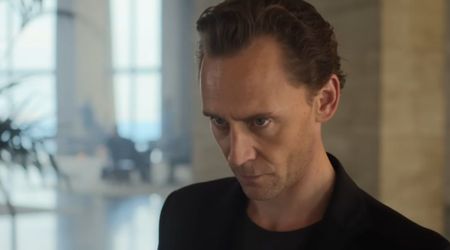Doctor Death: ITV's startling new docu takes a look at the life and death of the most prolific serial killer in history

UK commercial television channel, ITV, released a documentary on April 26 titled "Harold Shipman: Doctor Death" and it focuses on the case of Shipman who was a doctor convicted of poisoning his own patients.
Shipman is considered the most prolific serial killer in recorded history, and authorities concluded that he killed more than 200 of his patients.
The documentary was released on the 20th anniversary of Shipman's arrest and uses footage from his interrogation as well as interviews with the families of the victims.
The show portrays how the doctor, who hanged himself in his prison cell in 2004, chose his victims from a community which was the most susceptible to his devious plans.
In his first TV interview on the infamous serial killer, retired West Yorkshire police officer George McKeating reveals to the audience how far Shipman's drug addiction took him and how he was almost removed from the medical register. McKeating was the one who arrested Shipman for illegal drug possession and forging prescriptions in 1975. He revealed how he had found "track marks" down both of the serial killer's arms.
The documentary, which is an hour long, focuses on Shipman's case and the investigation that took place. The doctor was convicted of 15 counts of murder and one count of forgery.
ITV had previously spoken about the Shipman case in a two hour dramatised version of events back in 2002. The company behind the 2018 one hour documentary is Wild Pictures which is also the company behind other ITV award-winning documentaries like The Forgotten Children.
Who is Harold Shipman?
Harold Shipman was an English general practitioner born in 1946 and is known as one of the most prolific serial killers in recorded history so far. He studied medicine at Leeds School of Medicine and graduated from there in 1970. Shipman then started working at Pontefract General Infirmary in West Riding, Yorkshire. In 1974, he got a position as a general practitioner (GP) at the Abraham Ormerad Medical Center in Todmorden, West Yorkshire.
What did he do?
In 1975, he was caught forging prescriptions of pethidine (Demerol) for his own personal use. He was then fined £600 and was sent to a rehabilitation clinic in York for a brief moment. After this brief stint at rehab, he was made a GP at the Donneybrook Medical Center in Hyde, near Manchester, in 1977. Shipman worked as the GP in Hyde all through the 80s. In 1993, he started his own clinic at 21 Market Street and subsequently became a respected member of the community.
The unusually high death rate among Shipman's patients came to light after Linda Reynolds from the Donneybrook Surgery in Hyde spoke about her concerns to John Pollard who is the coroner for the South Manchester District in March 1998. She was particularly concerned about the volume of cremation forms that were being made for elderly women which Shipman needed to have countersigned. The issue was brought to the notice of the police who could not find enough evidence to make charges.
The Shipman Inquiry, as it was known, blamed the police later for not assigning experienced officers to the case. Between April 17, 1998, which was the time that the investigation was stopped, and the time when Shipman was eventually arrested, the doctor had killed three more people.
Kathleen Grundy was Shipman's last victim and she was found dead in her own home on June 24, 1998. The doctor was the last person to see her alive and later recorded "old age" as the cause of death in her death certificate.
Then, in August 1998, John Shaw, a taxi driver from the same area, called the police and told them that he had suspicions that Shipman had murdered 21 patients. Angela Woodruff, a lawyer and Grundy's daughter, started getting more concerned with the reports after Brian Burgess, a solicitor, told her that her mother had apparently made a will. There were many doubts as to whether this will was authentic because it did not include her or her children bit left the entire £386,000 to Shipman.
Burgess had told Woodruff to report it so she went to the authorities and the investigation began anew.
Grundy's body was then exhumed and when the corpse was examined, traces of diamorphine, which is used as a pain killer for terminally ill cancer patients, was found. Shipman had claimed at that time that the deceased woman was an addict and even showed the police comments that he had made on his computerised medical journal.
Unfortunately for Shipman, the computer's software showed that the comment was made after she died. The doctor was then finally arrested on September 7, 1998. A search found a typewriter that was the same kind used to make the forged will.
The police then slowly found other deaths that Shipman had certified and made a list of 15 specimen cases to investigate further. They found a pattern to the lethal doses of diamorphine, signing the death certificates for the patients, and then finally falsifying the medical records to make it look like they were all ill to begin with.
Shipma's highly publicised trial started on October 5, 1999, at the Preston Crown Court. He was charged with the murders of Marie West, Irene Turner, Lizzie Adams, Jean Lilley, Ivy Lomas, Muriel Grimshaw, Marie Quinn, Kathleen Wagstaff, Bianka Pomfret, Norah Nuttall, Pamela Hillier, Maureen Ward, Winifred Mellor, Joan Melia and Kathleen Grundy, who were all killed by lethal injections of diamorphine all between the years of 1995 and 1998. Shipman's legal representatives tried to have Grundy's case tried separately in court because a clear motive for it was only alleged whereas the motive for the other murders was not apparent.
The jury found Shipman guilty of 15 counts of murder and one count of forgery on January 31, 2000, after deliberating on the verdict for six days. The judge then sentenced Shipman to life behind bars on all the counts of murder and even gave a recommendation that he never be released. He was also slapped with a four year sentence for forging Grundy's will. Then, ten days after he was convicted, Shipman was finally removed from the medical register by the General Medical Council. Two years after that, in 2002, David Blunkett, the Home Secretary, confirmed the whole life sentence given by the judge. This happened just a few months before the ministers of the British government lost the power to set minimum terms for the prisoners convicted of crimes.
There were many additional charges that could have potentially been made against Shipman but the police decided that a fair trial would be impossible to be held because the initial case got too much publicity. They also made the decision not to make additional charges because the fifteen life sentences that were handed to Shipman made any further litigation redundant.
The doctor maintained his innocence till the end and had even disputed the scientific evidence that was brought against him multiple times. Shipman never once made any public statements about what he allegedly did and his wife, Primrose, also maintained her husband's innocence even after he was convicted and put behind bars.
Shipman has come to be known as the only doctor in British medicine history who was found guilty of murdering his own patients. Another doctor before Shipman, John Bodkin Adams, was charged in 1957 of murdering one patient and there were rumors that he had done away with dozens more over a course of 10 years.
The authorities believe that he is the one who "possibly provided the role model for Shipman". Adams was acquitted for the murder unlike Shipman. Pamela Cullen, a historian, has claimed that it is because of Adams' acquittal that the government did not see the need to look into the flaws of the British system until the Shipman case came along.
What happened after Shipman died?
One day before Shipman's 58th birthday on January 13, 2004, the disgraced doctor hanged himself in his cell at the Wakefield prison where he was being kept.
A statement by the police said that Shipman had somehow managed to hang himself from the window bars in his cell using bedsheets that the inmates were provided with.
Chris Gregg, a senior detective with the West Yorkshire police force, was chosen to lead an investigation into 22 mysterious deaths in the area in January 2001.
After this was announced, the Shipman inquiry that was ordered into the doctor's activities was submitted in July 2002; it concluded that he had killed 215 of his patients between 1975 and 1998.
Almost all of Shipman's victims were elderly women who clearly trusted him and did not realise he was taking advantage of them.
ITV's 2018 documentary on the serial killer, dubbed Doctor Death and Britain's worst serial killer, aired on April 26. Watch the one-hour documentary on the most prolific serial killer in recorded history HERE.










